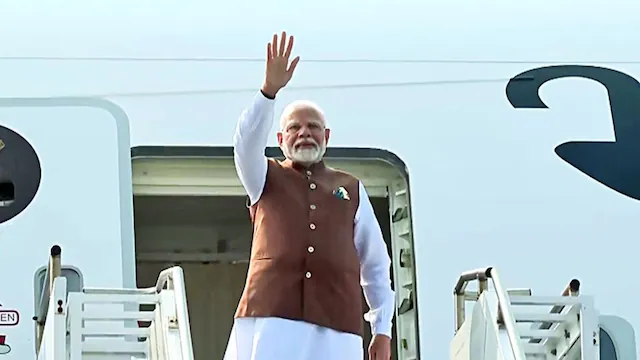India Under Modi: Democracy and Development
- MGMMTeam

- Apr 3, 2024
- 4 min read
Introduction
Recently a Japanese author wrote an article questioning India’s democracy and stating that India will slide into autocracy. As the Elections come closer, articles like these are going to be a lot more common as various Western Media agencies aim to discredit and destroy the image of PM Modi and his government.
The Article
The article expresses concerns regarding the decline of democratic institutions and secular values in India during Prime Minister Narendra Modi's tenure. It references multiple reports and analyses from organizations like V-Dem, Freedom House, and the Economist Intelligence Unit, which have downgraded India's democratic standing due to restricted freedoms for media, civil society, and opposition groups, alongside the rise of Hindu nationalism and biased policies against religious minorities, particularly Muslims.
It points out the weakening of accountability mechanisms such as the legislature, judiciary, and independent bodies like the Election Commission. The article also condemns the government's suppression of dissent, so-called control over media outlets, and limitations imposed on civil society organizations. Moreover, it discusses the upsurge of Hindu nationalism, or Hindutva, aiming to reshape India as a Hindu-majority nation, thereby marginalizing religious minorities. Instances of hate speech, boycotts, and violence against Muslims, as well as discriminatory laws curtailing their civil liberties, are cited.
Despite the government's dismissal of these criticisms and its efforts to portray India as the "world's oldest democracy," the article suggests a drift towards autocracy under the Modi administration.
Understanding Their Misconceptions
While the article raises concerns about the state of democracy under Prime Minister Narendra Modi's government in India, it's crucial to recognize the country's continued vibrancy as a democracy and its remarkable strides in development.
1. Democratic Institutions
India's democratic institutions, including the judiciary, free press, and civil society, remain robust, playing essential roles in upholding democratic principles. Notably, the Supreme Court of India has delivered landmark judgments safeguarding fundamental rights and curbing executive overreach, as seen in cases such as triple talaq and the Ram Mandir verdict. Despite challenges, the media landscape remains diverse, with numerous independent outlets actively scrutinizing the government's actions.
2. Inclusive Development Policies
Under the Modi administration, various initiatives and policies have been implemented to empower marginalized sections of society and foster inclusive development.
- Pradhan Mantri Awas Yojana: Providing affordable housing to the people of India.
- Ujjwala Yojana: Launched in May 2016, the Ujjwala scheme, abbreviated as PMUY, is a flagship initiative aimed at providing LPG connections to women from below poverty line (BPL) families. With the primary goal of improving health and reducing environmental impact by replacing traditional cooking fuels, the scheme has evolved over the years to become one of India's most successful social welfare programs.
3. Economic Reforms
Moreover, decisive steps have been taken to address long-standing issues such as corruption, infrastructure development, and economic reforms.
- Insolvency and Bankruptcy Code: The Insolvency and Bankruptcy Bill of 2015 enhances support for startups by enabling them to conclude operations within a 90-day period, thereby nurturing a dynamic business ecosystem.
- Goods and Services Tax (GST): Moves away from the previous system where multiple taxes were imposed at different points along the supply chain resulting in a cascading effect of taxes, often referred to as 'tax on tax.' This inflated tax increased the price of business for both businesses and consumers.
With the implementation of GST and the introduction of the input tax credit mechanism, businesses can now offset taxes paid on inputs. This prevents the occurrence of double taxation, consequently leading to a decrease in the ultimate price of goods and services.
4. Economic Growth Initiatives
India's rapid economic growth, driven by initiatives like Make in India and Digital India, has positioned the country as one of the fastest-growing economies globally. Despite challenges, such as disruptions in global supply chains and inflationary pressures, India's resilience and strong economic fundamentals have enabled it to maintain robust growth.
- Pradhan Mantri Jan Dhan Yojana: The Pradhan Mantri Jan-Dhan Yojana (PMJDY) is a national initiative aimed at achieving financial inclusion by providing access to essential financial services such as basic savings and deposit accounts, remittance, credit, insurance, and pension at affordable rates. Through this scheme, individuals who do not possess any other account can open a basic savings bank deposit (BSBD) account at any bank branch or Business Correspondent (Bank Mitra) outlet.
- Pradhan Mantri Mudra Yojana: Launched in 2015, PMMY aids small and micro enterprises by offering financial aid in the form of loans. It divides these loans into three categories – Shishu, Kishor, and Tarun – depending on the size of the business, thus ensuring customized financial assistance.
5. Healthcare Initiatives
In terms of healthcare, the government has focused on improving access and affordability through initiatives like:
- Ayushman Bharat: The Ayushman Bharat Scheme stands as the world's largest government-funded health insurance initiative. Covering over 500 million Indian citizens, the scheme has already provided its cashless and paperless medical services to more than 40 million beneficiaries. As a result, citizens have collectively saved nearly $7 billion, ensuring access to healthcare for all Indians.
Conclusion
While acknowledging valid concerns regarding minority rights and civil society, it's essential to recognize India's democratic framework's resilience, allowing for dialogue and course correction. Despite challenges, India remains committed to upholding democratic values and fostering an environment conducive to growth and prosperity for all its citizens.
In conclusion, while the concerns raised in the article are noteworthy, they present a partial view of India's progress under the Modi government. India's continued commitment to democracy, inclusive development initiatives, and economic reforms demonstrate its resilience and determination to build a better future for its people.




Comments